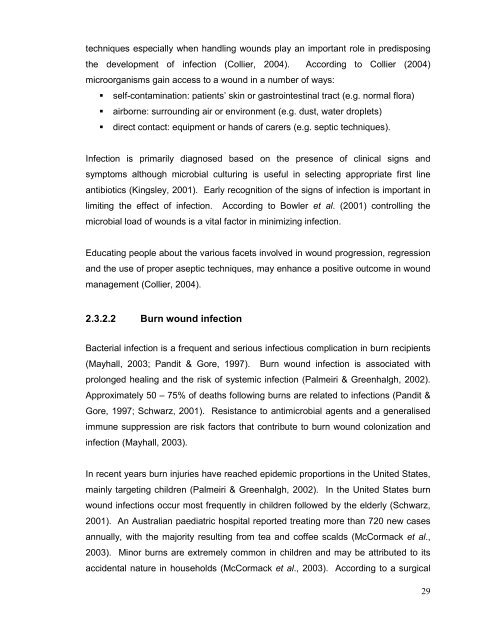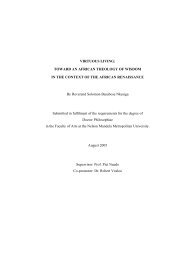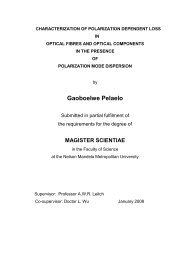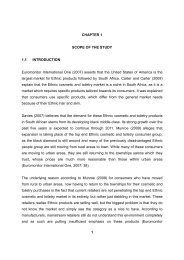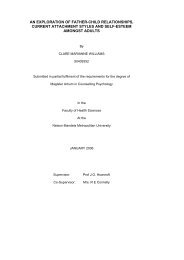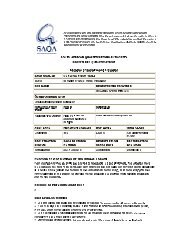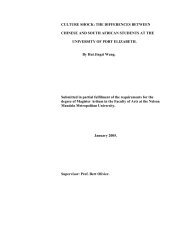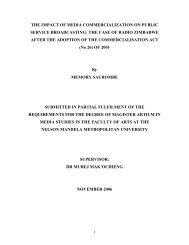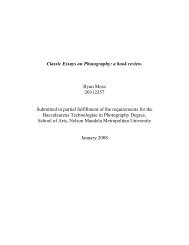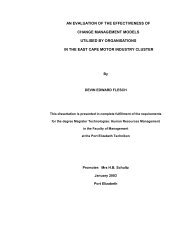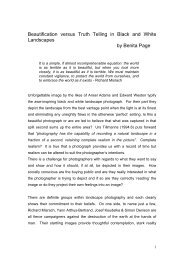an investigation into the antibacterial activities of medicinal plants ...
an investigation into the antibacterial activities of medicinal plants ...
an investigation into the antibacterial activities of medicinal plants ...
Create successful ePaper yourself
Turn your PDF publications into a flip-book with our unique Google optimized e-Paper software.
techniques especially when h<strong>an</strong>dling wounds play <strong>an</strong> import<strong>an</strong>t role in predisposing<br />
<strong>the</strong> development <strong>of</strong> infection (Collier, 2004). According to Collier (2004)<br />
microorg<strong>an</strong>isms gain access to a wound in a number <strong>of</strong> ways:<br />
self-contamination: patients’ skin or gastrointestinal tract (e.g. normal flora)<br />
airborne: surrounding air or environment (e.g. dust, water droplets)<br />
direct contact: equipment or h<strong>an</strong>ds <strong>of</strong> carers (e.g. septic techniques).<br />
Infection is primarily diagnosed based on <strong>the</strong> presence <strong>of</strong> clinical signs <strong>an</strong>d<br />
symptoms although microbial culturing is useful in selecting appropriate first line<br />
<strong>an</strong>tibiotics (Kingsley, 2001). Early recognition <strong>of</strong> <strong>the</strong> signs <strong>of</strong> infection is import<strong>an</strong>t in<br />
limiting <strong>the</strong> effect <strong>of</strong> infection. According to Bowler et al. (2001) controlling <strong>the</strong><br />
microbial load <strong>of</strong> wounds is a vital factor in minimizing infection.<br />
Educating people about <strong>the</strong> various facets involved in wound progression, regression<br />
<strong>an</strong>d <strong>the</strong> use <strong>of</strong> proper aseptic techniques, may enh<strong>an</strong>ce a positive outcome in wound<br />
m<strong>an</strong>agement (Collier, 2004).<br />
2.3.2.2 Burn wound infection<br />
Bacterial infection is a frequent <strong>an</strong>d serious infectious complication in burn recipients<br />
(Mayhall, 2003; P<strong>an</strong>dit & Gore, 1997). Burn wound infection is associated with<br />
prolonged healing <strong>an</strong>d <strong>the</strong> risk <strong>of</strong> systemic infection (Palmeiri & Greenhalgh, 2002).<br />
Approximately 50 – 75% <strong>of</strong> deaths following burns are related to infections (P<strong>an</strong>dit &<br />
Gore, 1997; Schwarz, 2001). Resist<strong>an</strong>ce to <strong>an</strong>timicrobial agents <strong>an</strong>d a generalised<br />
immune suppression are risk factors that contribute to burn wound colonization <strong>an</strong>d<br />
infection (Mayhall, 2003).<br />
In recent years burn injuries have reached epidemic proportions in <strong>the</strong> United States,<br />
mainly targeting children (Palmeiri & Greenhalgh, 2002). In <strong>the</strong> United States burn<br />
wound infections occur most frequently in children followed by <strong>the</strong> elderly (Schwarz,<br />
2001). An Australi<strong>an</strong> paediatric hospital reported treating more th<strong>an</strong> 720 new cases<br />
<strong>an</strong>nually, with <strong>the</strong> majority resulting from tea <strong>an</strong>d c<strong>of</strong>fee scalds (McCormack et al.,<br />
2003). Minor burns are extremely common in children <strong>an</strong>d may be attributed to its<br />
accidental nature in households (McCormack et al., 2003). According to a surgical<br />
29


